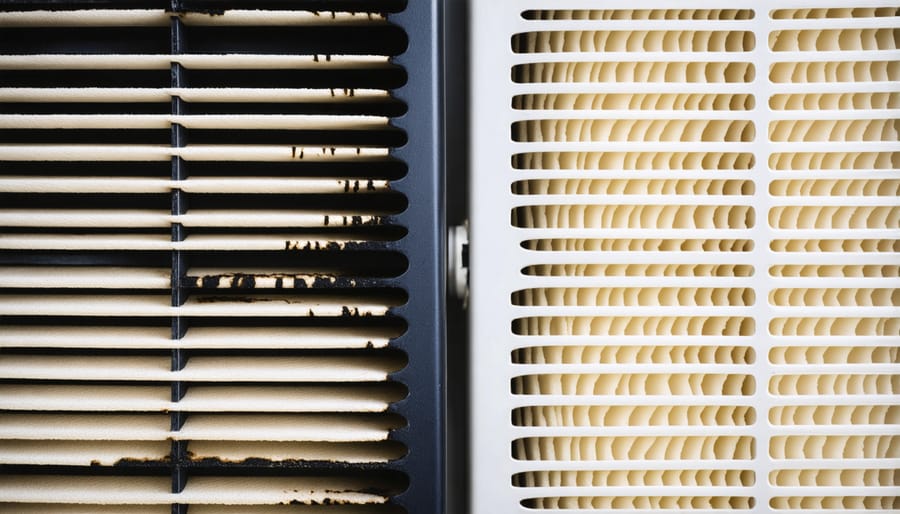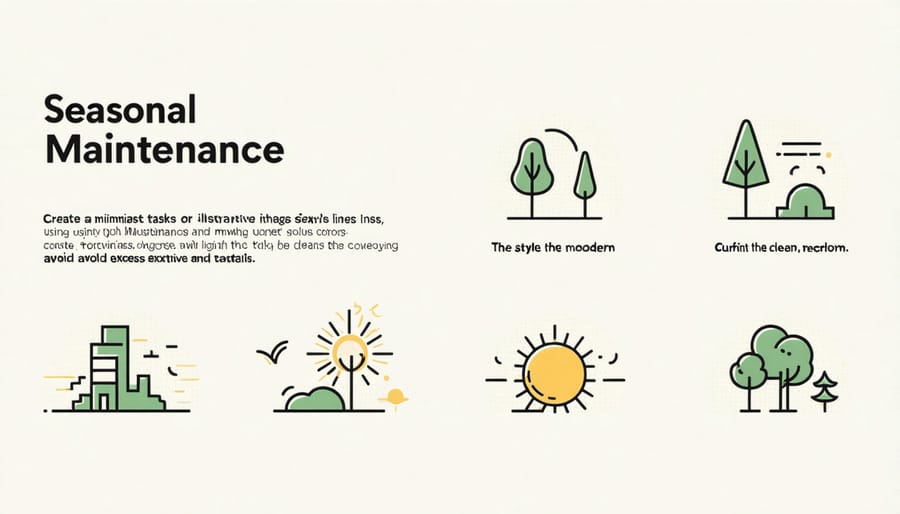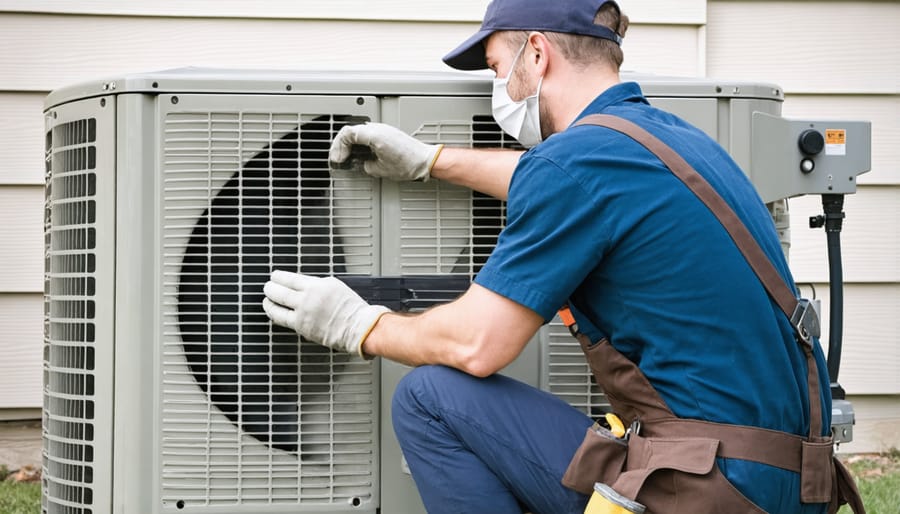Regular air conditioner maintenance protects your investment and keeps energy bills in check. Most homeowners overlook essential AC care until problems arise, but following a simple maintenance schedule prevents costly breakdowns and extends system life by 5-10 years.
Change or clean your air filter every 30-90 days, depending on pets, allergies, and local air quality. Clean the outdoor condenser unit and remove debris monthly during peak cooling season. Schedule professional maintenance twice yearly – once in spring before cooling season begins, and again in fall to prepare for winter shutdown.
Watch for warning signs like unusual noises, weak airflow, or inconsistent cooling – these indicate your system needs immediate attention. Proactive maintenance costs far less than emergency repairs and helps maintain optimal efficiency, saving up to 15% on monthly cooling costs while ensuring reliable comfort when you need it most.
Monthly AC Maintenance Tasks You Can Do Yourself
Filter Checks and Replacement
Regular filter maintenance is one of the most crucial yet simple tasks to improve indoor air quality and keep your AC running efficiently. For most homes, checking your air filter monthly and replacing it every 60-90 days is ideal. However, this schedule can vary depending on several factors.
If you have pets, live in a dusty area, or have family members with allergies, you might need to replace filters more frequently – sometimes as often as every 30 days. During peak cooling seasons, when your AC runs constantly, more frequent checks are also recommended.
To check your filter, hold it up to a light source. If you can’t see light passing through, it’s time for a replacement. Always keep spare filters on hand and mark your calendar for regular checks. When replacing, make sure to note the correct size and direction of airflow (marked by arrows on the filter frame).
Remember, a clean filter not only ensures better air quality but also helps your system run more efficiently, potentially reducing energy bills and preventing unnecessary wear on your AC unit.

Basic Cleaning and Inspection
Regular monthly cleaning and inspection of your air conditioner can prevent many common issues and keep your system running efficiently. Start by turning off your AC unit before performing any maintenance tasks. Clean or replace the air filter every 30 days – this simple step alone can reduce energy consumption by up to 15%.
Give your outdoor unit some attention by gently clearing away leaves, twigs, and debris from around the condenser. Use a garden hose to wash the unit’s exterior, spraying at a 45-degree angle to remove dirt without damaging the fins. Inside your home, vacuum the vents and registers to remove dust buildup.
During your monthly inspection, listen for unusual noises when the system starts up, and check for any water leaks around the indoor unit. Ensure all vents are unobstructed by furniture or curtains. Take a moment to verify that the thermostat is working correctly and displaying accurate temperatures.
Keep an eye on your energy bills – sudden increases might indicate your system needs attention. If you notice any concerning changes in performance, unusual odors, or strange sounds, it’s best to contact a professional.
Seasonal Maintenance Checklist

Spring Preparation
As winter fades away, it’s crucial to prepare your air conditioning system for the upcoming heat. Spring is the perfect time to maintain your AC in summer performance and ensure everything’s in working order before temperatures rise.
Start by removing any protective covers you might have placed during winter and clear away debris, leaves, or branches that have accumulated around your outdoor unit. Give the exterior unit a gentle cleaning with your garden hose, spraying from top to bottom to remove dirt and grime.
Next, replace or clean your air filters – this simple task can significantly improve your system’s efficiency. Check your thermostat’s functionality by running a brief test cycle. Listen for unusual noises and pay attention to how quickly your home reaches the desired temperature.
Inspect your condensate drain line for any clogs or buildup, and clean it using a mixture of warm water and vinegar. Examine all visible ductwork for signs of damage or disconnection, and ensure all vents throughout your home are unobstructed.
This is also the ideal time to schedule your annual professional maintenance visit. A certified technician can perform a thorough inspection, identify potential issues before they become problems, and ensure your system is ready for peak performance during the hottest months ahead.
Fall Shutdown Care
As summer fades into fall, giving your AC system a proper shutdown ensures it’ll be ready for next season. Start by giving your unit a final cleaning, removing any debris, leaves, or dirt that accumulated during the summer months. This helps prevent rust and corrosion during the off-season.
Next, give your system one final run for about 30 minutes. Listen for unusual noises and check for any issues that might need addressing before winter. Once complete, turn off the power at both the thermostat and the exterior disconnect switch near your outdoor unit.
Consider installing a waterproof cover for your outdoor unit, but make sure it’s completely dry first. The cover protects against winter debris while preventing moisture buildup that could damage internal components. However, don’t wrap the unit too tightly – some airflow is necessary to prevent mold growth.
Inside your home, clean or replace the air filter one final time and check that all vents are clean and unobstructed. This is also an excellent time to schedule any needed repairs you noticed during the season, as HVAC professionals are typically less busy during fall.
Finally, make notes about any concerns or irregular performance you observed during the cooling season. This information will be valuable for your spring startup maintenance and helps track your system’s performance over time.

Professional Service Schedule
Annual Tune-up Components
A professional AC tune-up includes several essential components that ensure your system runs efficiently throughout the cooling season. Your technician will start by inspecting and cleaning the condenser and evaporator coils, which are crucial for heat transfer. They’ll check refrigerant levels and test for any leaks that could compromise performance.
The inspection also covers electrical connections, tightening loose components and checking for signs of wear. Your technician will clean or replace the air filter, ensuring it works alongside your proper ventilation system to maintain good air quality.
Other key maintenance tasks include lubricating moving parts, calibrating the thermostat, and checking the condensate drain line for clogs. The technician will also inspect the blower motor, fan blades, and belts, making adjustments or replacements as needed.
During this visit, they’ll also verify that your system’s safety controls are functioning correctly and test the startup cycle to ensure everything operates smoothly. This comprehensive check helps prevent unexpected breakdowns and extends your AC’s lifespan while maintaining optimal energy efficiency throughout the season.
When to Schedule Extra Service
While regular maintenance schedules are essential, certain signs indicate your AC system needs immediate attention. Pay attention to unusual noises like grinding, squealing, or rattling, as these often signal mechanical issues that require prompt inspection. If you notice warm air blowing from your vents or weak airflow, this could indicate problems with your system’s components or ductwork.
A sudden spike in your energy bills might suggest your AC is working harder than necessary, warranting a professional check-up. Unusual odors, particularly musty or burning smells, should never be ignored as they could indicate mold growth or electrical issues. If your system starts short cycling (turning on and off frequently) or runs constantly without reaching the desired temperature, it’s time to call a technician.
Watch out for water leaks around your unit or excessive humidity in your home, as these can signal drainage problems or refrigerant issues. If your AC system is more than 10 years old and showing any of these symptoms, you might want to schedule more frequent maintenance checks. Additionally, if you live in an area with high pollution or construction, or if you have pets, consider increasing your maintenance frequency to keep your system running efficiently.
Maintenance Frequency Based on Usage Factors
Your AC maintenance schedule isn’t one-size-fits-all – several key factors determine how often you’ll need to service your unit. If you live in a dusty area or near construction sites, you’ll want to check and clean your filters monthly rather than quarterly. Coastal residents should be extra vigilant due to salt air exposure, which can accelerate corrosion and require more frequent system checks.
Usage patterns play a crucial role too. Running your AC 24/7 during summer months? You’ll need more frequent maintenance than someone who uses their unit occasionally. Homes with pets or multiple occupants typically require more frequent filter changes due to increased dust and debris accumulation.
The age of your system also matters significantly. Newer units (1-5 years old) might do fine with annual professional check-ups, while older systems often need semi-annual inspections to maintain efficiency. If your unit is over 10 years old, consider scheduling professional maintenance every six months.
Climate impacts maintenance needs too. In regions with long, hot summers, your AC works harder and needs more attention. Similarly, if you live in an area with high humidity, you’ll want to check your condensate drain more frequently to prevent clogs and water damage.
Pay attention to your energy bills and cooling performance – unexpected changes often signal it’s time for maintenance, regardless of your regular schedule.
Regular AC maintenance is your key to ensuring a comfortable home and avoiding costly repairs down the road. Remember to perform monthly filter checks and cleaning, conduct seasonal inspections during spring and fall, and schedule professional maintenance annually. By following these maintenance intervals, you’ll extend your AC’s lifespan, maintain optimal energy efficiency, and prevent unexpected breakdowns. Think of it as an investment that pays off through lower energy bills and fewer repair costs. The few hours you spend maintaining your AC throughout the year can save you thousands in the long run and keep your home consistently cool when you need it most. Stay proactive with your maintenance schedule, and your AC will reward you with reliable performance year after year.
